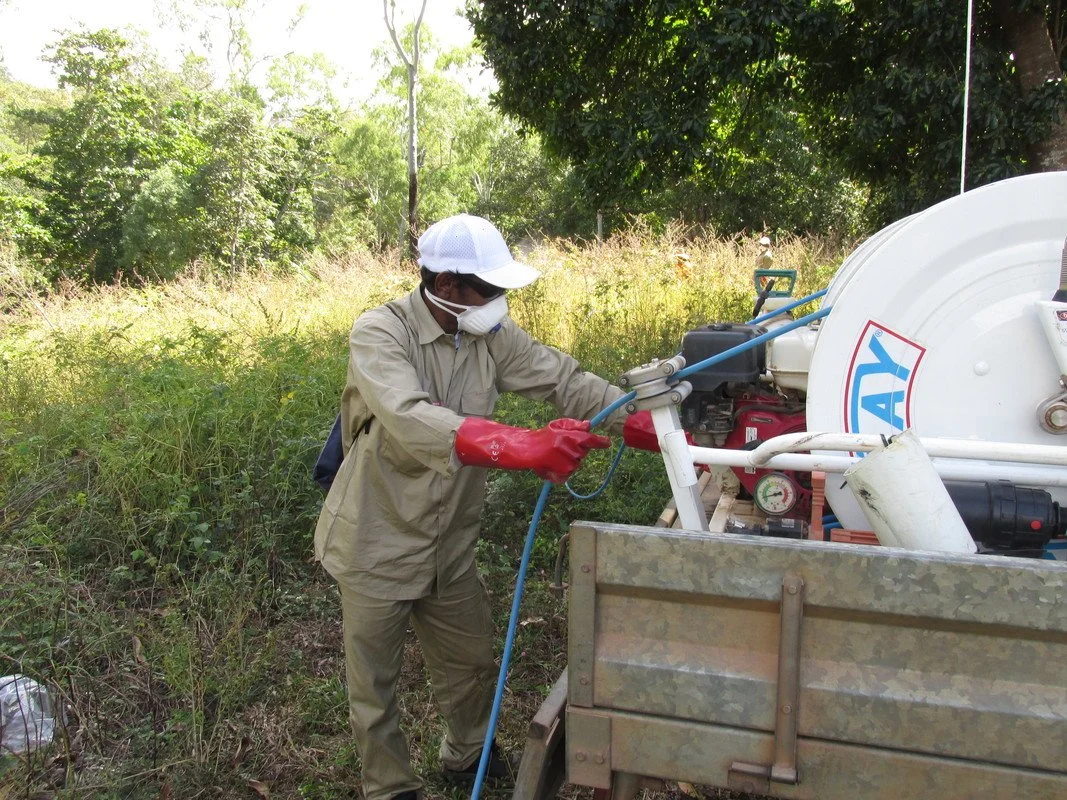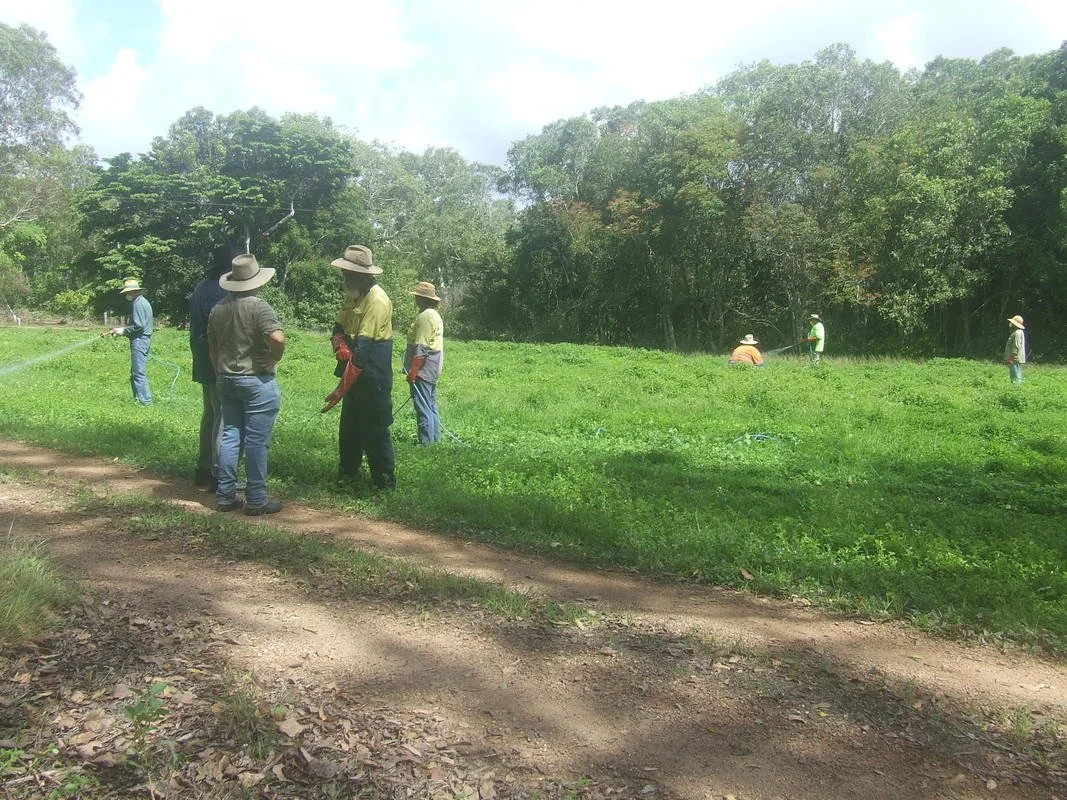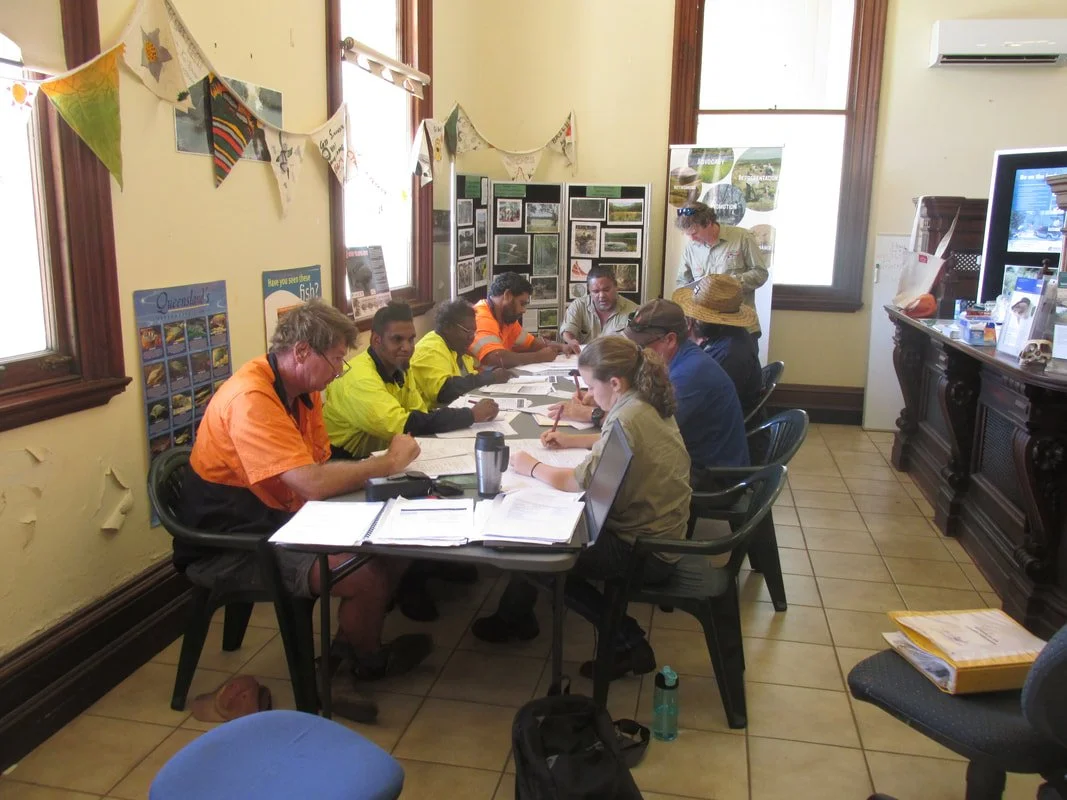Progress Performance Report June-July 2018
We have been working in partnership with Cape York Natural Resource Management Limited, as a part of our QFPIR2 # -Sub Program 1, Sub Program 2 & Sub Program 3.
As a result of delays in getting the program up and running, we have been able to complete certain sections of Milestones One through to Milestone Four.
Progress Report for the period 31/11/2017 to 01/06/2018
Sub Project One
• Had steering committee meetings held at Cooktown with participating committee members, CYWAFAI_INC staff and Regional Landcare Facilitator to schedule project and develop operational works plans.
• We have completed two fully accredited AC-DC courses.
• We have also commenced working with the fifteen signed up landholders.
• This has consisted of helping them with their weed control on their individual properties. We have helped build up tremendous capacity within the landholders.
• Individual graziers and horticulturists have been commenting on how much better prepared they are to be able to make their weeds and feral animal control more effective.
• They were impressed that it has actually saved them money and has helped make their land more productive.
• We promoted the project through attending several community events.
• Media article developed for Cape York NRM Healthy Country newsletter on QFPI project.
• Cape York NRM sponsored the 14th QLD Weed Symposium at Port Douglas on 4-7 December and we promoted the QFPI project at the Cape York NRM stall in partnership with CYWAFAI_INC staff.
• We promoted our project at Bromely Rangers AC-DC Training at Hopevale.
• The QFPI- Project was also promoted at the Cape York Local Marine Advisory Committee workshop, held on the 12 / 07 / 2018.
• Overall, there has been some delays to the completion dates listed in the contract, however, project milestones underway and planning is on track for successful delivery.
• Conducted the Steering Committee meeting for the Project via phone hook-up on 23 April 2018
• As a part of our Capacity Building Project we worked with several landholders, providing them with capacity to actually control the declared weeds on their own properties.
• By actually working with the landholders, we completed their Property Pest Management Plans.
• We built up the experience and capacity of the landholder to carry out weeds ID and chemical and non-chemical control methods for the weeds identified as a priority on each of their pest management. This included the Declared Weeds under the Biosecurity Act 2014.
• Before it got too dry we managed to provide capacity to seven of the landholders.
These were:
1) Beat & Sasha Rothlisberger- Horticulture
Summary of Works Include:
Total Area Surveyed and Controlled 30 Ha
Foliar Sprayed Sickle pod, Lantana, Rats-tail grass, and Gamba grass
Basal barked Lantana and Bauhinia in the more environmentally sensitive areas.
2) Tony Holmes- Sam-Reta- Horticulture
Summary of Works Include:
Total Area Surveyed and Controlled _ 36.4 Ha
Foliar Sprayed Sickle pod and Lantana.
Basal barked Lantana in the more environmentally sensitive areas.
3) Martin Pattie – Horticulture
Summary of Works Include:
Total Area Surveyed and Controlled _ 10.11 Ha
Foliar Sprayed Sickle pod, Lantana, and Rats-tail grass.
Basal barked Lantana in the more environmentally sensitive areas.
4) BonnyGlen Station - Graziers
Summary of Works Include:
Total Area Surveyed and Controlled _142,000. 00 Ha
Foliar Sprayed Sickle pod, Rubber Vine, and Gamba grass
Basal barked Rubbervine and Calotrope in the more environmentally sensitive areas.
5) Mt Dowling Station – Graziers
Summary of Works Include:
Total Area Surveyed and Controlled _ 258.99 Ha
Foliar Sprayed Sickle pod, Lantana, and Rats-tail grass.
Basal barked Lantana in the more environmentally sensitive areas.
6) Rick Reid & Cassie Sorensen – Horticulture
Summary of Works Include:
Total Area Surveyed and Controlled _ 18.19 Ha
Foliar Sprayed Sickle pod, Lantana, and Rats-tail grass.
Basal barked Lantana in the more environmentally sensitive areas.
7) Valley View – Graziers
Summary of Works Include:
Total Area Surveyed and Controlled_ 373.87 Ha
Foliar Sprayed Sickle pod, Lantana, and Rats-tail grass.
Basal barked Lantana in the more environmentally sensitive areas
Sub Project Two QFPI-Landholder —AC/DC Herbicide Training
Course One 05/02/2018 - 09/02/2018
• Conduct AC/DC training for the horticulturists and graziers who will be conducting weed control work, on their respective properties.
This work is being conducted as a part of the Cape York Weeds and Feral Animals, Incorporated, and Cape York NRM Queensland Feral Pest Initiative Project.
Cape York Weeds and Feral Animals Program are working in conjunction with individual properties as a part of the strategic control of locally declared and other declared weed infestations in the South East Cape York Area.
This includes all the productive land areas within Laura Valley, Cooktown, Endeavour Valley, Mt Amos and Rossville.
• The main objective is to strategically eliminate weeds and to improve the productivity of their properties, located in Cape York Peninsula.
• The secondary goal is to reduce the spread of this species down the river systems and along road networks. Because of the increased vehicular traffic due to traditional owner movement, tourism and various causes, the biggest challenge is to reduce weed seed spread into previously clean areas.
• Weeds such as Sicklepod, Lantana, Singapore Daisy, Gamba Grass etc are also being spread throughout the roads and river systems of these farming systems.
• The main aim of the AC/DC training was to give the graziers and horticulturists the necessary skills to be able to strategically target all the weeds that have been identified in their pest management plan, as well as their core land management responsibilities.
• It was decided to go to the Mallee Leuca property in the Endeavour Valley, as they were set up for the training and the practical components of the training.
• The weather interrupted our program, delaying the completion by two days.
• The eight landholders were:
Horticulturists: Councillor John Giese, Charlie Lamb, Martin Pattie, Rick Reid, Cassandra Sorensen, Dale and Leslie Burke
Graziers: Ron Tiemstra
• Because the weather delayed our training completion date by two days, Horticulturist, Cassie Sorensen had to return to work for the final practical exercise part of the course.
• We completed this part for her on the weekend after the course.
• The landholders were shown how to safely spray, safe chemical use, the safe operation of a spray unit, and basic weeds ID. The full AC/DC course was delivered, along with all the latest weed control and herbicide mixing techniques.
• The techniques used were extensively practiced, giving the landholders as much practical experience as possible.
• The control program was mainly concentrating on the Declared Species on the land and water courses on the Mallee Leuca property.
• As the lantana consisted of grown plants well over two metres high, the basal barking technique was actively worked well.
• The crew was professional and keen. They worked hard to practice their new skills.
• I found them to be willing to have a go and very conscientious.
• Control work was conducted well and thoroughly.
• Training on the use of GIS mapping techniques was briefly given.
• We did what we could get to and everything was mapped, and data sheets completed.
• Travelled home.
• Vehicles and all gear were cleaned up. Maintenance sheets were completed.
• Because the AC/DC was carried out over the full three days, more practical work was able to be carried out.
• Eric Dick helped me deliver the successful training modules. We had a few dramas with weather, but we managed to complete all the training outcomes, despite everything.
The graziers and horticulturists are to be commended on their efforts and their willingness to help. They were keen to work as a team.
QFPI-Landholder —AC/DC Herbicide Training Course Two 12/03/2018 - 14/03/2018
• We conducted the second block of AC/DC training for the Aboriginal Rangers, horticulturists and graziers who will be conducting weed control work, on their respective properties.
• This involved a further nine trainees. Bringing the number up to seventeen, out of a total of thirty-five people who are encouraged to take up the training.
• This work is being conducted as a part of the Cape York Weeds and Feral Animals, Incorporated, and Cape York NRM Queensland Feral Pest Initiative Project.
• Cape York Weeds and Feral Animals Incorporated are working in conjunction with individual properties, ranger groups, and eligible community members.
• This forms a part of the strategic control of locally declared and other declared weed infestations in the South East Cape York Area. This includes all the productive land areas within Laura Valley, Cooktown, Endeavour Valley, Mt Amos and Rossville.
• The main objective is to strategically eliminate weeds and to improve the productivity of their properties, landholdings and aboriginal land, located in Cape York Peninsula.
• The secondary goal is to reduce the spread of this species down the river systems and along road networks. Because of the increased vehicular traffic due to traditional owner movement, tourism and various causes, the biggest challenge is to reduce weed seed spread into previously clean areas.
• Weeds such as Sicklepod, Lantana, Singapore Daisy, Gamba Grass etc are also being spread throughout the roads and river systems of these farming systems.
• The main aim of the second AC/DC training course was to give the graziers, Ranger groups, eligible individuals, and horticulturists the necessary skills to be able to strategically target all the weeds that have been identified in their pest management plan, as well as their core land management responsibilities.
• It was decided to go to the Gungarde owned community farm property in the Endeavour Valley, as they were set up for the training and the practical components of the training.
• The weather was kind and allowed us to complete the full course.
• The nine landholders were:
Horticulturists: Tony Holmes, Geoff Bird, Nathan Jacobs
Aboriginal Rangers: Herbert Henderson, Julieann McIvor, Thomas Ling, Neville Bowen, Deborah Wallace, and South Cape York Catchments Katelyn Greaves
• Because the weather was very kind to us we successfully completed all modules.
• The Landholders were shown how to safely spray, safe chemical use, the safe operation of a spray unit, and basic weeds id. The full AC/DC course was delivered, along with all the latest Weed control and Herbicide mixing techniques.
• The techniques used were extensively practiced, giving the landholders as much practical experience as possible
• The control program was mainly concentrating on the Declared Species on the land and water courses on the Gungarde owned farm property.
• Several weed control techniques were used to control weeds on the Gungarde property, including foliar spraying and basal barking. With the added ability to be able to identify what weeds were on the property, the landholders were able to design an effective control plan for the Gungarde farm.
• After successful employing the foliar spraying technique, on the smaller declared weed species, the group started using the basal barking techniques, on the Bauhinia along the water course.
• As the Bauhinia species consisted of grown plants well over two metres high, the basal barking technique was actively used and worked well.
• The crew was professional and keen. They worked hard to practice their new skills.
• I found them to be willing to have a go and very conscientious.
• Control work was conducted well and thoroughly.
• Training on the use of GIS mapping techniques was briefly given.
• We did what we could get to and everything was mapped, and data sheets completed.
• Travelled home.
• Vehicles and all gear were cleaned up. Maintenance sheets were completed.
• Because the AC/DC was carried out over the full three days, more practical work was able to be carried out.
• Eric Dick helped me deliver the successful training modules. All in all, we managed to complete all the training outcomes, in spite of everything.
The graziers, rangers, and horticulturists are to be commended on their efforts and their willingness to help. They were keen to have a go.
Sub Project Three : Pond Apple Progress Report QFPI
Progress Report for the period 31/11/2017 - 01/06/2018.
As a part of our contract with Cape York NRM, we were to expand our Pond Apple survey and control area.
• Having had a wet season, we started on the project as soon as we could access all areas.
• We conducted the expansion of the project in conjunction with our normal control programs.
• We completed two full trips which contributes to the Expanded QFPI-Pond Apple Project.
• Liaised with local landholders along all Pond Apple areas.
• We have yet to complete a survey and control trip with the Jabalbina Ranger T/O group.
• We also surveyed areas to the north, south and west of each coastal Pond Apple area, to see if any new Pond Apple could be found.
• Met up at the CYWAFA_INC office where we went through risk assessment, workplace health and safety, toolbox talk.
• Met up at the beginning of the Pond Apple infestation near the racecourse on Two Mile Creek which was the location of our Expanded Pond Apple Project Area.
• We also found extra Pond Apple plants at our Cedar Bay Pond Apple areas along the east coast of Cape York Peninsula.
• We then continued the control work along Two Mile until we reached the end of the swampy area.
• W conducted Pond Apple control using 'cut stump' and basal barking methods.
• . Finished up in the afternoon with revision of herbicide mixing ratios and data sheet filling.
• The last area to be worked on was the Mt Amos infestation.
• When we got there, it was still a lot wetter than we expected.
• We further surveyed the area for any pond apple that was out of water and controlled what we could.
• Mapped all of control work. The data and herbicide usage sheets were also completed.
• Because it was so wet, it reduced the amount of Pond Apple area controlled.
• Approximately 1.2ha of the expanded Pond Apple area was controlled and further 8ha of area was surveyed.
• Very little was found outside of the recently discovered areas.
• Photos were taken including photo points along the various treatment sites.
• All areas of control work have been mapped using the GIS systems, and put on to QGIS maps.
• The data and herbicide usage sheets were also completed.
• The Pond Apple Control Program was extremely successful considering it was reasonably wet in the swampy areas.
• The Weeds Control Program was extremely successful, due to the fact that a smaller number of regrowth seedlings are being controlled each time.
CYWAFA_INC, Cape York NRM, and Traditional Owners, are to be commended for their professionalism and willingness to get the job done.




